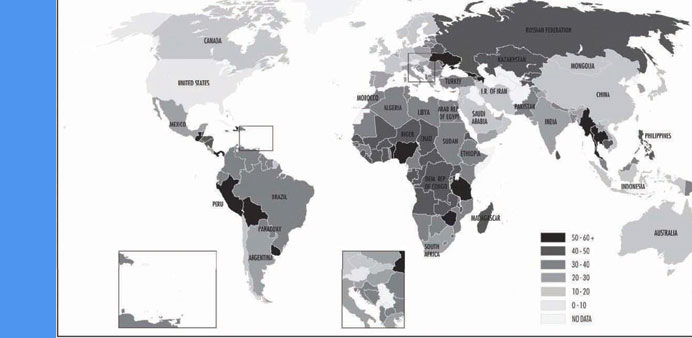A World Bank visualisation of global shadow economies. The figures mean the percentage of GDP the informal sector constitutes in a country.
By Arno Maierbrugger/Gulf Times Correspondent/Bangkok
Thailand’s informal economy, the non-regulated, non-taxed part of its overall economy, made up 40.9% of the country’s GDP in 2014. This is the surprising number Friedrich Schneider, an economist at Johannes Kepler University of Linz in Austria, who has done studies on underground economies all over the world, was quoted as saying in a recent Bloomberg feature on Thailand that focused on the effects the military’s crackdown on corruption had on the country – in fact almost none.
Taking Schneider’s number, in money terms, the shadow economy in Thailand would have generated more than $155bn of illicit revenue last year.
”If this revenue was just taxed by the general 7% value-added tax, the Thai government could have brought in almost $11bn for state coffers, 12 times more than it has earmarked for desperately needed water management projects for 2015 and 2016 to cope with droughts and floods that alternately batter the country,” a Thai economist told Gulf Times, asking to withhold his name as he is not authorised by his institution to speak to the media.
Visible informal business in the country is widespread and consists of street vendors, food stalls, souvenir sellers, repair shops, makeshift entertainment venues and so forth, while in the darker corners across the country illegal lotteries, street drug trade, gasoline smuggling, human trafficking, informal money lending and small weapons trade are rife. For all those businesses, no one pays tax, no one is licensed and no one is documented. Bribes are paid instead that disappear in pockets of people who constitute a food chain of corruption that stretches up to the highest echelons.
Bloomberg Business ranks Thailand seventh-biggest shadow economy in the world as per the share of illicit revenue of a country’s GDP. On the list, the “Land of Smiles” appears alongside Peru, Bolivia, Ukraine, Belarus, Tanzania, Zimbabwe, Haiti, Guatemala and the likes, and within Southeast Asia, it comes along with Myanmar, Cambodia and the Philippines. In an earlier World Bank ranking, Thailand is even prominently listed at a 50+-percentage its informal sector is contributing to GDP.
However, the shadow economy is also absorbing a large number of young Thais, particularly from rural families, who are exiting a basic public education system with little skills which leaves them with few options on the labour market. Stuck with low-income jobs and monetary demands from their ageing parents, who in turn are unable to survive on their meagre public pensions, these youths are left with no incentives or opportunities to improve their job situation, and only the shadow economy is actually holding the entire system together.
In a way, the government seems to accept the informal sector as constituting part of the country’s economic ecosystem. Otherwise it would be impossible to release official unemployment rates that have been below 1% for years, with 0.56% as of end-2014 being the latest officially published figure, a jobless rate among the lowest in the world. The explanation is that the Thai statistics office sees all the people working in the informal sector as “self-employed” or at least “under-employed”, from the street noodle stall owner to the odd shoe-shine boy, which keeps them out of the jobless statistics.
In turn, Thailand’s official economy isn’t doing so well at the moment, with business leaders complaining that the government is “too slow” in tackling the economic downturn. Last year, Thailand’s GDP grew by only 0.7%, the slowest in four years and the weakest in Southeast Asia, and this year it would be a surprise if growth would climb above 3%, economists believe.

